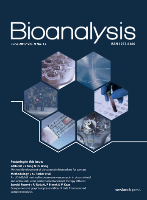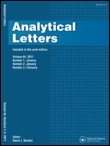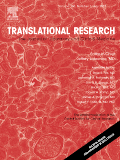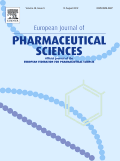
Bioanalysis
Scope & Guideline
Advancing the frontiers of bioanalytical science.
Introduction
Aims and Scopes
- Bioanalytical Method Development:
The journal emphasizes the development of robust and sensitive bioanalytical methods, particularly those utilizing techniques such as LC-MS/MS, HPLC, and immunoassays for quantifying drugs and biomarkers in various biological matrices. - Regulatory Compliance and Guidelines:
Papers often discuss the implications of regulatory guidelines (like ICH M10) on bioanalytical practices, providing insights into best practices for method validation, quality control, and compliance in bioanalytical laboratories. - Emerging Technologies in Bioanalysis:
The journal highlights innovative methodologies such as microsampling, digital PCR, and microfluidics, which aim to enhance the sensitivity, efficiency, and sustainability of bioanalytical assays. - Clinical Applications and Pharmacokinetics:
A core focus is on the application of bioanalytical methods in clinical pharmacokinetics, pharmacodynamics, and therapeutic drug monitoring, with studies addressing the challenges in patient-centric drug assessments. - Biomarker Discovery and Validation:
The journal covers research on the identification and validation of biomarkers for disease diagnosis and treatment monitoring, emphasizing the integration of bioanalytical techniques in biomarker research. - Immunogenicity Assessment:
There is a consistent focus on the assessment of immunogenicity for biotherapeutics, including the development of assays for anti-drug antibodies and their implications for drug efficacy and safety.
Trending and Emerging
- Microsampling Techniques:
Recent publications highlight the increasing use of microsampling techniques, which allow for less invasive sample collection and reduced sample volumes, making them particularly valuable in pediatric and clinical settings. - Integration of Artificial Intelligence and Automation:
There is a growing trend towards incorporating AI and automation in bioanalytical workflows to enhance efficiency, data analysis, and assay development, reflecting broader technological advancements in the field. - Focus on Sustainability in Bioanalysis:
Studies addressing green bioanalytical practices, including eco-friendly sample preparation and solvent use, are emerging, highlighting the industry's commitment to sustainability and environmental impact reduction. - Advancements in Immunogenicity Testing:
The journal has seen an increase in research focusing on the complexities of immunogenicity testing for biologics, emphasizing the need for improved methodologies to assess anti-drug antibodies and their clinical implications. - Multi-Omics Approaches:
There is a notable trend toward multi-omics approaches in bioanalysis, integrating genomics, proteomics, and metabolomics to provide comprehensive insights into drug action and patient response.
Declining or Waning
- Traditional Assays and Techniques:
There appears to be a waning interest in traditional bioanalytical techniques such as standard ELISA and older chromatographic methods, as newer, more sensitive technologies like LC-MS/MS and immunocapture assays gain prominence. - Focus on Single-Analyte Assays:
The journal has seen a decrease in studies focused solely on single-analyte assays, with a trend toward multiplexing and simultaneous quantification methods that provide broader insights into pharmacokinetics and drug interactions. - Methodologies with Limited Clinical Relevance:
Papers focusing on methodologies that lack direct clinical applications or relevance to current therapeutic areas are becoming less common, indicating a shift towards more clinically applicable research.
Similar Journals

ACTA POLONIAE PHARMACEUTICA
Pioneering Research in Pharmaceutical TechnologyACTA POLONIAE PHARMACEUTICA is a well-established peer-reviewed journal published by Polskie Towarzystwo Farmaceutyczne, dedicated to the field of pharmaceutical sciences and pharmacology. With a rich history dating back to 1951, this journal serves as a vital platform for disseminating cutting-edge research and developments in pharmaceutical technology, drug development, and therapeutic therapies. Although it currently operates under a subscription model, its commitment to scientific rigor has earned it a respectable impact factor, placing it in the Q3 and Q4 quartiles respectively for Pharmaceutical Science and Pharmacology as of 2023. Researchers and practitioners alike will find value in its comprehensive coverage of essential topics, as well as its diverse range of contributions from both established and emerging scholars in the field. With its address located in the heart of Warsaw, Poland, ACTA POLONIAE PHARMACEUTICA aims to further bridge the gap between academia and industry, paving the way for innovation in drug discovery and therapeutic applications.

Separation Science Plus
Fostering knowledge exchange in analytical advancements.Separation Science Plus is an emerging academic journal dedicated to advancing the field of analytical chemistry and separation science. Published by WILEY-VCH Verlag GmbH, this journal provides a platform for researchers to disseminate high-quality studies and reviews that address innovative techniques and breakthroughs in separation methodologies. With its ISSN 2573-1815, the journal has made significant inroads since its inception in 2018, encompassing a convergence period until 2024. Despite currently holding a Q3 ranking in Analytical Chemistry and a Q4 ranking in Filtration and Separation, its dedication to publishing impactful research makes it a vital resource for professionals and students alike. The journal operates under the robust scholarly reputation of WILEY, which is known for its commitment to excellence in scientific communication. Researchers interested in the latest advancements in separation techniques will find Separation Science Plus an essential read, fostering the exchange of knowledge and facilitating greater understanding within this specialized field.

CHEMICAL RESEARCH IN CHINESE UNIVERSITIES
Shaping the Future of Chemical Research in ChinaCHEMICAL RESEARCH IN CHINESE UNIVERSITIES is a prominent academic journal dedicated to the dissemination of high-quality research in the field of chemistry and related educational methodologies. Published by HIGHER EDUCATION PRESS, this journal has established itself as a vital resource for researchers and professionals looking to stay at the forefront of chemical sciences. With an impressive impact factor and ranked in the Q2 quartile for both Chemistry and Education categories, it highlights significant advancements while maintaining rigorous peer-review standards. The journal's ISSN is 1005-9040 and its E-ISSN is 2210-3171, ensuring broad accessibility to its global readership. Although it does not offer open access, its contributions are vital to understanding the dynamics of chemistry research and education within and beyond China. With converged publication years from 1999 through to 2024, CHEMICAL RESEARCH IN CHINESE UNIVERSITIES continues to be an essential platform for innovative studies and critical discussions in the expanding realm of chemistry.

BIOPHARM INTERNATIONAL
Unveiling Breakthroughs in Drug DevelopmentBIOPHARM INTERNATIONAL, published by Advanstar Communications Inc, is a notable journal in the realms of biotechnology and pharmaceutical sciences, with an ISSN of 1542-166X and an E-ISSN of 1939-1862. Since its inception in 2002, the journal has established a platform for the dissemination of innovative research and comprehensive reviews that delve into the intricate interface of biopharmaceutical development and technological advances. Despite its current standing in the Q4 quartile for both Biotechnology and Pharmaceutical Science categories, its commitment to quality and relevance continues to attract contributions from a diverse cadre of researchers and academics. The journal operates within the US, catering to a global audience, and focuses on themes ranging from drug formulation to biotechnological breakthroughs. While the journal currently offers limited Open Access options, it remains a critical resource for those looking to navigate the evolving landscape of pharmaceutical innovations. Researchers, professionals, and students alike will find valuable insights that are essential for staying abreast of key trends and advancements in their fields.

AAPS Journal
Shaping the Future of Pharmaceutical Research and Applications.AAPS Journal, published by Springer in the United States, is a leading peer-reviewed journal dedicated to the advancement of research in the field of Pharmaceutical Sciences. With an impressive Q1 rank in its category and a position within the 81st percentile of Scopus rankings, it serves as a vital resource for researchers and professionals seeking to disseminate impactful findings and innovative methodologies. The journal publishes high-quality original research, review articles, and technical reports aimed at addressing the multifaceted challenges in pharmacology, toxicology, and pharmaceutics. Operating under an Open Access model, AAPS Journal ensures broad dissemination of knowledge, contributing to the enhanced visibility and accessibility of research outputs. With a publication window spanning from 1999 to 2024, it continues to shape the future of pharmaceutical research and its applications. Researchers, students, and industry professionals will find a valuable repository of cutting-edge knowledge in this esteemed journal.

ANALYTICAL LETTERS
Empowering Scientists with Cutting-edge FindingsANALYTICAL LETTERS is a reputable journal published by Taylor & Francis Inc, focusing on the dynamic fields of analytical chemistry, biochemistry, and clinical biochemistry. With an ISSN of 0003-2719 and an E-ISSN of 1532-236X, the journal has been a platform for scholarly articles since its inception in 1967, and is set to continue its contribution to the scientific community until 2024. Despite its classification in Q3 across various categories as of 2023, including analytical chemistry and spectroscopy, ANALYTICAL LETTERS maintains a significant impact within its field, evidenced by its moderate rankings within Scopus. This journal serves as a vital resource for researchers and professionals seeking to explore recent advancements in analytical methodologies, instrumentation, and applications, facilitating the dissemination of critical insights in laboratory practices. With access primarily through institutional subscriptions, it remains positioned as a crucial tool for those advancing knowledge and innovation in analytical sciences.

Analytical and Bioanalytical Chemistry Research
Bridging Disciplines in Analytical and Bioanalytical Chemistry.Analytical and Bioanalytical Chemistry Research is an esteemed open-access journal published by the Iranian Chemical Society, dedicated to the advancement of knowledge in the fields of analytical chemistry, biochemistry, and spectroscopy. Since its inception in 2014, this journal has provided a platform for researchers, professionals, and students to publish and access high-quality research articles that contribute to the understanding of chemical analysis and bioanalytical methods. With an ISSN of 2383-093X and an open-access model that promotes global dissemination of findings, it ensures that innovative research reaches a broad audience. The journal has consolidated its presence in the scientific community, currently ranked in quartile Q4 for analytical chemistry, biochemistry, and spectroscopy as of 2023. Its Scopus rankings, including a percentile of 34th in Analytical Chemistry, reflect its commitment to quality research and scholarly contribution. Situated in Tehran, Iran, the journal serves as a vital resource for academic discourse, offering insights into emerging trends and methodologies in analytical and bioanalytical chemistry.

Translational Research
Catalyzing Breakthroughs for Tomorrow's HealthcareTranslational Research, published by Elsevier Science Inc, stands at the forefront of the rapidly evolving fields of biochemistry, medicine, physiology, and public health. With an impressive 2023 Q1 ranking in these categories, this journal has established itself as a critical platform for disseminating innovative research that bridges the gap between laboratory findings and clinical application. The journal, which has been converging knowledge since 2006, is committed to advancing scientific understanding and improving health outcomes by publishing high-quality articles that reflect rigorous peer review and impactful findings. With its impressive Scopus rankings, including a rank of #5 in Biochemistry and #7 in Physiology, it is an essential resource for researchers, practitioners, and students dedicated to the translation of scientific breakthroughs into real-world health solutions. Transitioning to an open-access model, the journal enhances accessibility and engagement, inviting a global audience to participate in the discourse shaping the future of healthcare and disease management.

EUROPEAN JOURNAL OF PHARMACEUTICAL SCIENCES
Elevating Pharmaceutical Science through Rigorous ResearchThe European Journal of Pharmaceutical Sciences is a prestigious academic journal dedicated to advancing the field of pharmaceutical science. Published by Elsevier, the journal boasts an impressive impact factor and is categorized in the Q1 quartile for pharmaceutical science as of 2023, signifying its influence and reputation within the academic community. With a Scopus ranking of #20 out of 183 in the fields of pharmacology, toxicology, and pharmaceutics, the journal provides a vital platform for researchers and practitioners to disseminate innovative studies and groundbreaking research that push the boundaries of drug development and delivery. Based in the Netherlands and operating since 1993, the journal seeks to cover a broad scope of topics related to pharmaceutical sciences, encouraging rigorous evaluations and discussions that enhance the understanding and application of this critical field. The absence of open access underscores the commitment to maintaining high scholarly standards, while still offering avenues for libraries and institutions to provide access to cutting-edge research. As the journal converges towards its 2024 milestones, it continuously aims to foster a vibrant exchange of knowledge among its diverse readership, comprising committed researchers, professionals, and students.

ACTA PHARMACEUTICA
Fostering collaboration through open-access research excellence.ACTA PHARMACEUTICA is a distinguished open-access journal published by SCIENDO, dedicated to advancing knowledge in the fields of medicine and pharmaceutical sciences. Established in 1992, the journal has made significant contributions to the scholarly community, providing a platform for innovative research and discussion. With a strong presence in both Q2 and Q3 quartiles across various categories including Pharmaceutical Science and Pharmacology, ACTA PHARMACEUTICA ranks favorably, positioning its contributions in the upper tiers of the field. The journal's commitment to open access since 2007 ensures that both practitioners and scholars have immediate access to cutting-edge developments, thereby fostering collaboration and knowledge sharing. With its scope spanning a broad spectrum of pharmaceutical and biomedical research, ACTA PHARMACEUTICA is an essential resource for researchers, professionals, and students keen to stay abreast of the latest advancements and trends in these vital areas of study.